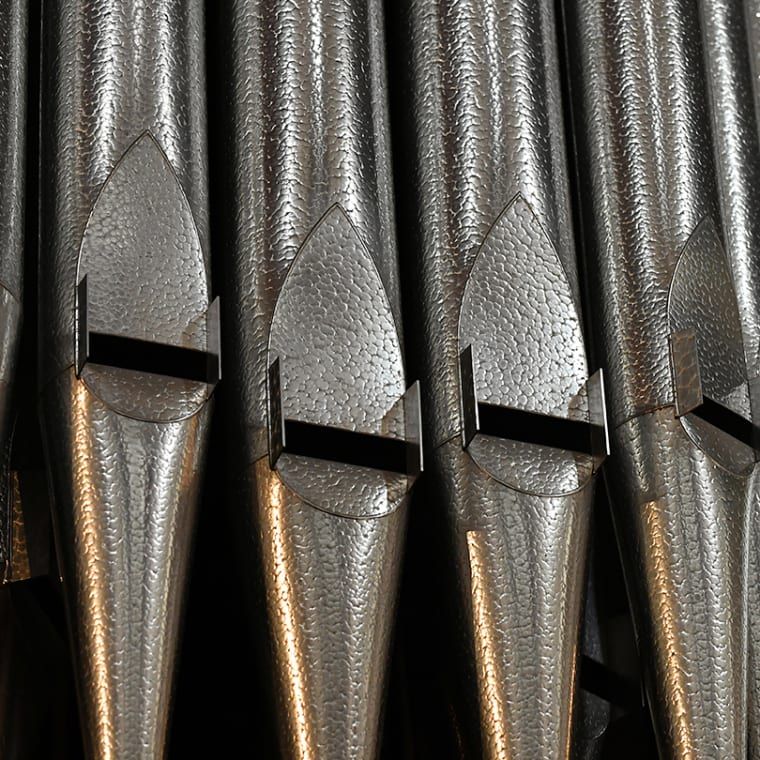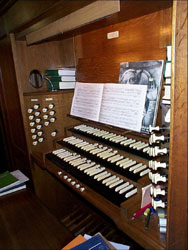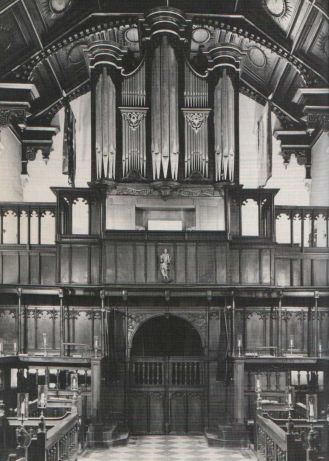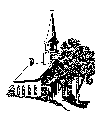


|
Great Organ Bourdon 16'� Diapason 8� Gamba 8' Hohn Flute 8' Principal 4� Harmonic Flute 4� Twelfth 2.2/3� Fifteenth 2� Mixture III Trumpet 8� |
Swell Organ Salicional 8� Voix Celeste 8' Bass Flute 8� Principal 4� Triangular flute 4' Fifteenth 2� Mixture II Mixture III Fagott 16' Oboe 8� Trumpet 8' Clarion 4' Tremulant Swell Octave/Sub Octave/Unison Off |
Choir Organ Gedact 8� Dulcet 4' Flute 4� Fifteenth 2� Sesquialtera II Trumpet 8' Clarinet 8� Tremulant |
|
Pedal Organ Open Wood 16� Bourdon 16� Gedact 8� Gamba 8� Gamba 4� Super Octave 2� Trombone 16� Trumpet 8� |
Couplers & Accessories S/G S/C S/P G/P C/P C/G Great/Swell/Choir: 8 Thumb Pistons (8 MemoryChannels) General: 8 Thumb Pistons/4 Toe Pistons (8 Memory Channels) G/P,S/G,S/P, C/P, S/C, Sw Trem: Reversible Thumb Pistons G/P,S/G: Reversible Toe Pistons |


PETERHOUSE CHAPEL WINDOWS SUITE

THE CATHEDRAL AND ABBEY CHURCH OF ST ALBAN'S, HERTFORDSHIRE, ENGLAND

THE CHAPEL OF ST MARGARET'S SCHOOL, BUSHEY, HERTFORDSHIRE, ENGLAND


|
Great Organ Stopped Diapason (8') Principal (4') Fifteenth (2') Nineteenth (1.1/3') Swell to Great Swell Octave to Great Swell Sub-Octave to Great |
Swell Organ Chimney Flute (8') Dulciana (8') Open Flute (4') Oboe (8') Swell Octave Swell Sub-Octave Unison Off |
Pedal Organ Bourdon (16') Bass Flute (8') Great to Pedal Swell to Pedal |



|
Great Organ Open Diapason 8�* Stopped Diapason 8� Principal 4�* Nason Flute 4� Twelfth 2.2/3�* Fifteenth 2�* Mixture II Trumpet 8� |
Swell Organ Salicional 8� Stopped Diapason 8�* Principal 4�* Fifteenth 2� Mixture III Oboe 8� |
Choir Organ Echo Dulciana 8�* Stopped Diapason 8�* Flute 4�* Principal 4�* Gemshorn 4� Nazard 2.2/3� Gemshorn 2� Tierce 1.3/5� Larigot 1.1/3� Trumpet 8� |
|
Pedal Organ Open Diapason 16� Bourdon 16� Octave 8� Flute 8� Fifteenth 4� Flute 4� Trombone 16� Trumpet 8� Clarion 4� |
Couplers & Accessories S/G S/C S/P G/P C/P Great/Pedal Combined Great/Swell/Choir: 5 Thumb Pistons Pedal/Swell: 5 Toe Pistons G/P,S/G,C/P: Reversible Thumb Pistons G/P,S/G,C/P: Reversible Toe Pistons |
Compass Manuals: C-g3 Pedals: C-f1 |

